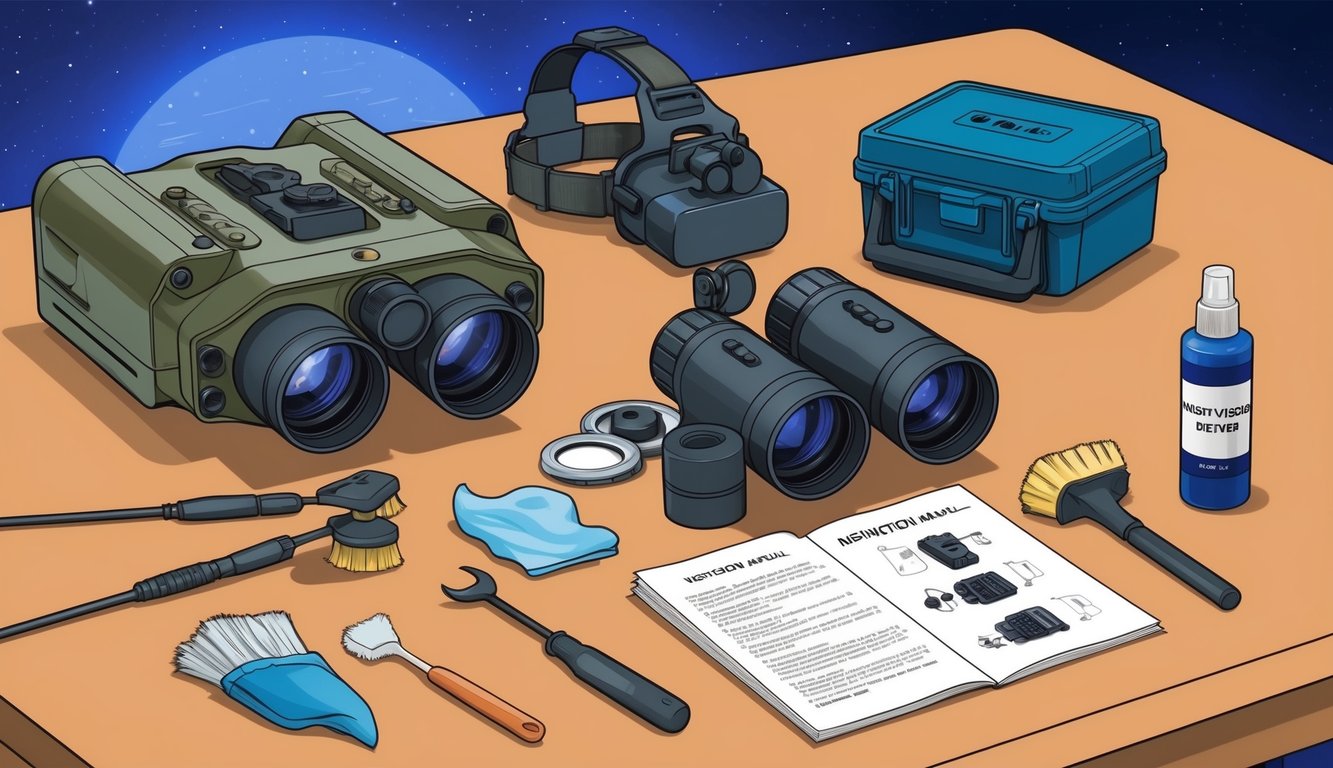Have you ever noticed those unusual devices worn by military personnel on their helmets during nighttime operations? These gadgets, called NODs, are essential in contemporary warfare and tactical endeavors.
NODs, or Night Observation Devices, are advanced optical systems designed to enhance vision in low-light scenarios, enabling users to see clearly in darkness.
NODs are available in several formats, from monocular units that are used with one eye to binocular models that provide a broader field of vision.
These devices function by amplifying available light, such as moonlight and starlight, to produce a visible image.
Some cutting-edge NODs even feature thermal imaging technology, which helps in detecting heat signatures to identify potential threats or targets.
The evolution of NODs has transformed military operations, granting soldiers a significant edge in nighttime combat situations.
Their application, however, isn’t confined to the military; law enforcement agencies, search and rescue teams, and civilian outdoor enthusiasts have also found valuable uses for these night vision tools.
Key Takeaways
- NODs amplify ambient light to provide clear vision in darkness
- These devices come in various types, including monocular and binocular options
- Night vision technology has applications beyond military use, benefiting various sectors
Understanding Nods as Signals
Nods are powerful nonverbal signals conveying meaning across diverse cultures and contexts.
You’ll find that these simple head movements can indicate approval, understanding, or even serve as military commands in particular situations.
Cultural Interpretations
You may not realize that the way you nod can carry different meanings depending on your location in the world.
In most Western nations, an up-and-down nod typically signifies agreement or approval.
However, in Bulgaria and Greece, this same movement signifies “no.”
In Japan, a quick nod might indicate that you’re listening rather than agreeing.
In German culture, a firm single nod conveys respect or agreement.
Meanwhile, in India, a side-to-side head wobble can mean “yes,” “I understand,” or “okay.”
Acknowledging these cultural nuances can help you avoid misunderstandings while traveling or interacting with individuals from different backgrounds.
Military Commands and Signals
Nods carry surprising importance in military contexts.
In the U.S. Armed Forces, a decisive nod can act as a silent command or acknowledgment.
During the Vietnam War, POWs used subtle nods to secretly communicate with one another.
Soviet forces also incorporated nods into their silent communication strategies, enabling coordination without alerting the enemy.
In contemporary military operations, nods are utilized for selection processes, such as choosing team members or signaling targets.
A swift nod from a commander can indicate approval for an action or confirm a soldier’s readiness.
Nods in Technology: Night Vision Devices
Night Observation Devices (NODs) have revolutionized operations in low-light environments.
These advanced tools amplify existing light to provide clear visibility in darkness, enhancing capacity across military, law enforcement, and civilian applications.
Generations of Night Vision Technology
The first generation of night vision devices marked the beginning of modern technology.
They offered basic light amplification, albeit with limitations in image clarity and brightness.
Generation 2 introduced significant enhancements, offering a 20x increase in light amplification and improved image resolution.
Generation 3 devices represent the current standard, delivering 30,000x to 50,000x light amplification with lower power consumption.
These NODs offer clearer images and maintain performance in extremely low-light conditions.
Some manufacturers advertise “Generation 4” devices, but these are technically advanced Generation 3 or “Gen 3+” systems, often incorporating features like auto-gating for enhanced performance in varying light scenarios.
Key Features of Night Vision Equipment
Night vision goggles commonly utilize image intensifier tubes to amplify available light.
These tubes convert photons to electrons, enhance them, and subsequently revert them to visible light on a phosphor screen.
Many NODs also include infrared illuminators, providing additional light that is invisible to the naked eye but detectable by the device, thereby enhancing visibility in total darkness.
Modern night vision scopes often possess:
- Adjustable gain control
- Built-in rangefinders
- Compatibility with weapon mounting systems
- Water and shock resistance
Designed for military use, NODs are typically lightweight and durable, and they can be helmet-mounted, allowing for hands-free operation during missions.
Some advanced systems even feature thermal imaging capabilities alongside standard light amplification.
Night Vision Optics Specifics
Night vision devices come in various configurations to meet different user needs.
The choice between monoculars, binoculars, and goggles influences functionality and overall experience.
Binoculars vs Monoculars
Night vision binoculars provide depth perception and a broader field of view, making them ideal for surveillance and navigation.
Although they are generally more costly, they offer a more natural viewing experience.
Monoculars, conversely, are compact and lightweight, making them easy to mount on helmets or weapons.
They are often favored by law enforcement for their versatility and affordability.
Gen 3 devices in both configurations present superior image quality compared to Gen 1, delivering clearer visuals and better performance in very low light conditions.
Goggles and Their Uses
Night vision goggles are hands-free devices that enable mobility and equipment operation while maintaining visibility in darkness.
They are prevalent in military and tactical operations.
Goggles come with either single or dual tubes.
Dual-tube designs, such as the PVS-31, enhance depth perception and situational awareness.
Some models are designed to fold outward, positioning closer to the helmet for improved comfort during prolonged use.
Digital night vision goggles are gaining popularity, featuring capabilities like video recording and thermal imaging integration.
These might be beneficial for hunting or outdoor adventures.
Advancements in Night Vision
Night vision technology has evolved significantly since its inception.
You’ll observe notable improvements in image quality, light amplification, and overall performance across device generations.
Evolution from Gen 1 to Gen 3
The initial generation of night vision devices relied on ambient light amplification, producing a basic green-tinted image that was often grainy and distorted.
Generation 2 introduced essential upgrades, including microchannel plates for better resolution and decreased noise.
Gen 3 devices, the standard in modern military use, feature gallium arsenide photocathodes, delivering clearer images and better performance in extremely low-light conditions.
You’ll notice sharper details and less image distortion compared to earlier versions.
With each new generation, there have been improvements in battery life and reductions in weight.
The quality of the objective lens has also been enhanced for better light-gathering capabilities.
Thermal Imaging Versus Image Intensifiers
Image intensifiers amplify available light, while thermal imaging detects heat signatures.
You might opt for an image intensifier NVG when you need to identify details like facial features or read text.
Thermal imaging excels in complete darkness or through obstacles like smoke and fog, allowing for the detection of warm objects, making it effective for locating hidden targets.
However, you’ll sacrifice some detail compared to image intensifiers.
Some advanced systems combine both technologies, allowing users to switch between thermal and light amplification modes for optimal performance in various conditions.
Historical Significance and Development

Night vision devices have been pivotal in military operations and technological advancements.
You’ll learn how these tools have influenced warfare and discover the key innovators behind their creation.
Night Vision in World Conflicts
During World War II, the Germans were at the forefront of developing early night vision technology, with the AEG company creating the first operational infrared device designed for tanks, granting them a competitive advantage in nocturnal warfare.
The Cold War instigated a fierce competition in night vision technology, with the Soviet Union and the United States heavily investing in development.
American snipers during the Vietnam War utilized starlight scopes, providing significant leverage to U.S. forces.
In modern warfare scenarios, night vision has become a standard resource, crucial for special operations, reconnaissance, and urban combat.
This technology has saved countless lives and reshaped military strategies.
Pioneers in Night Vision Technology
RCA was a pioneer in night vision research back in the 1930s, impressively developing the image converter tube that amplified near-infrared light.
Vladimir K. Zworykin, often acknowledged as the “father of television,” made significant contributions, particularly in electron optics, laying the foundation for image intensification.
In the 1960s, ITT and Varo Inc. were the first to create wearable night vision devices, advancing the technology further by making it lighter and more effective.
Today, leading companies like L3Harris and Elbit Systems continue pushing innovations, enhancing image quality, reducing weight, and increasing durability for military and civilian applications.
Nods in Language and Communication
Nods are integral to our nonverbal communication, with these simple head movements conveying meaning across cultures and languages, although specific interpretations can differ.
Nods as Non-Verbal Cues
When you nod your head, you’re using a powerful non-verbal cue.
A single nod typically signals approval or understanding, while multiple rapid nods may express enthusiasm or prompt someone to continue speaking.
Slow nods can indicate contemplation or skepticism.
In many Western societies, an up-and-down nod signifies “yes” or approval.
However, be mindful that a side-to-side shake may not universally indicate “no.”
Nods also serve as cues for turn-taking in conversations, letting others know when you’re listening or when you’re done speaking and it’s their turn to respond.
Nods Across Different Languages
Though nodding is a common gesture worldwide, its meaning isn’t universally interpreted.
In some cultures, the direction of the nod can dramatically alter its significance.
In Czech, Russian, and Bulgarian cultures, an up-and-down nod often means “no,” while a side-to-side motion indicates “yes,” contrary to the interpretation in many Western regions.
In Korean culture, a slight upward nod may serve as a form of greeting.
Similarly, in parts of Greece and Turkey, an upward nod can signify “no.”
A quick upward nod in Malay culture may function as a pointing gesture, guiding toward a direction without using hands.
Understanding these cultural variations can enhance your ability to navigate international communication effectively.
Market Insights and Industry Trends

The night vision industry is witnessing rapid growth and innovation, with key players breaking new ground through advanced technologies and emerging applications across various fields.
Current Market Leaders
ATN Night Vision stands out in the market with its state-of-the-art devices, offering a diverse range of products catering to military, law enforcement, and civilian requirements.
In Europe, the Thales Group takes the lead with sophisticated night vision solutions.
The U.S. military represents a significant consumer, driving a demand for high-performance equipment.
L3Harris Technologies and Elbit Systems also play vital roles, supplying cutting-edge night vision gear to armed forces around the globe.
These companies continuously improve their offerings, concentrating on reducing weight, enhancing resolution, and boosting durability.
Emerging Trends in Night Vision Technology
Digital night vision is becoming increasingly popular, providing clearer images and features like video recording.
There’s a noticeable trend toward integrating thermal imaging, enabling users to identify heat signatures even in total darkness.
Augmented reality overlays are gaining traction, equipping users with real-time information and enhanced situational awareness.
Miniaturization is another significant trend, with manufacturers crafting smaller, more compact devices without compromising performance.
In the civilian sector, there’s a rise in affordable options for outdoor enthusiasts and home security applications.
This democratization of night vision technology is paving the way for new opportunities for everyday users.
Tips and Guidelines for Selecting Nods

Night vision devices, or nods, can significantly enhance your ability to navigate in low-light conditions.
Selecting the right nods requires mindful consideration of several factors and familiarity with key specifications.
Factors to Consider when Buying Nods
When choosing nods, assess your specific needs and the scenarios in which you’ll be using them.
The environment—urban or forested—might dictate different feature requirements.
Weight is crucial, especially for extended wear.
Lighter nods alleviate neck strain during protracted use.
Battery life is another vital consideration.
Look for models equipped with long-lasting batteries or compatible with widely available types.
Consider your budget as well.
While premium models deliver superior performance, mid-range options can still offer excellent functionality for many users.
Also, check compatibility with your existing gear, such as helmets or weapon systems.
Understanding Specifications and Features
Gain tube generation is a significant specification to consider.
Gen 3 tubes deliver the best performance, though they come at a higher price point.
Resolution is typically measured in line pairs per millimeter (lp/mm), where higher values indicate clearer images, especially at greater distances.
The field of view (FOV) influences how much you can observe at once, with wider FOVs generally offering better situational awareness.
Additionally, look for the minimum illumination level; lower values signify better performance in extremely dark settings.
The signal-to-noise ratio affects image clarity, with higher ratios leading to less “noise” or graininess in images.
Consider whether the nods include features like auto-gating for protection against sudden bright lights or manual gain control for adjusting brightness levels.
Maintenance and Care for Night Vision Devices

Proper maintenance is crucial for ensuring your night vision devices function optimally over time.
Regular care will prolong the life of these valuable tools.
Routine Care Practices
Clean your night vision device after each use.
Employ a soft, lint-free cloth to gently wipe down the exterior.
For lenses, use a microfiber cloth or lens tissue.
Avoid harsh chemicals or abrasive materials—stick to mild soap and water for stubborn grime.
Ensure thorough drying to prevent moisture damage.
When not in use, store your device in a cool, dry location, using the provided carrying case to shield it from dust and damage.
Prevent exposure to bright light sources, as this can impair the delicate internal components.
Always use the lens cap when the device is not in use.
Recommended Maintenance Intervals
Conduct a basic inspection before each use, checking for loose parts, cracks, or damage to the housing.
Ensure the battery compartment is clean and devoid of corrosion.
Monthly, cleanse the battery contacts and examine the ion barrier film for any signs of wear.
Regularly replace batteries to keep leakage at bay.
Schedule annual professional maintenance for recalibration, internal inspections, and replacing worn components.
Following exposure to harsh conditions, like heavy rain or saltwater, prompt servicing is recommended to mitigate long-term damage from environmental exposure.
Frequently Asked Questions

Night vision devices often lead to various inquiries regarding their functionality, types, and regulations.
Familiarizing yourself with the technology, options, and legal aspects can aid in making informed choices about these advanced optical tools.
How does night vision technology work in military equipment?
Night vision devices amplify existing light, including infrared light that is invisible to the human eye.
They utilize image intensifier tubes to capture and enhance available light, resulting in a green-tinted image presented to the user.
This technology enables military personnel to see distinctly in low-light environments.
What are the differences between monocular and binocular night vision devices?
Monocular devices engage one eye, offering a lightweight alternative with an extended field of view.
Binocular devices deliver depth perception and lessen eye strain, making them preferable for prolonged use, although they tend to be heavier and pricier.
What factors should one consider when looking for quality night vision gear?
Vital considerations include resolution, light amplification, and field of view.
The Figure of Merit (FOM) score synthesizes these factors, with higher scores indicating superior performance.
Battery life, durability, and compatibility with other gear are also crucial factors to evaluate.
How has night vision technology evolved in the defense sector?
Night vision technology has progressed from bulky, range-limited devices to compact, high-resolution systems.
Modern models provide enhanced image quality, extended range, and improved performance in low-light settings.
Integration with complementary technologies, such as thermal imaging, has further advanced their functionalities.
What are the legal considerations when purchasing military-grade night vision equipment?
Regulations can differ by country and occasionally by state.
In the U.S., most consumer-grade night vision devices are legal to possess.
However, certain advanced or export-controlled units may necessitate special permits or be limited to military and law enforcement use.
Can civilians legally own and use night vision devices?
In numerous countries, including the U.S., civilians are permitted to own and utilize night vision devices.
Nonetheless, specific models may be regulated or subject to export laws.
It’s advisable to verify local regulations prior to purchasing or using these devices.

